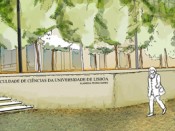
Dynamics of calcite cementation: evidence from giant carbonate reservoirs
por
Rachel Woods
School of GeoSciences, The University of Edinburgh, UK, and International Centre for Carbonate Reservoirs.
14 de Novembro, 16h00, sala 6.1.36, no edifício C6 da Faculdade de Ciências da Universidade de Lisboa. Campo Grande, Lisboa.
Resumo:
Oil charge is thought to inhibit the growth of cements within subsurface pore systems, and so equivalent non-hydrocarbon reservoir rocks at similar burial depths often show a greater volume of cement.
This has been inferred to be due to a longer history of cementation. We explore this phenomenon in eight vertically stacked reservoirs from two giant Cretaceous carbonate oil fields. Here, the oil-filled crest porosity ranges from 10-50% and permeability up to 830 mD, but the aquifer (flank) porosity is reduced to 10-23% and permeability to 0.1-4 mD.
Although the paragenetic sequence of the major pore-occluding calcite macrocements in the oil-leg and aquifer follows the same cement succession, the volumetrics and timing of cement formation as revealed by in-situ ion microprobe δ18O data notably differ. Oil leg cements show 11 CL zones, where pore-filling cements (>30 µm diameter) are represented by 1-1.5% fringing cement, 3.5-6.7% inter-granular equant cements that increase with reservoir depth, and 1.3-7% blocky calcite cement that also increases with reservoir depth. This contrasts with aquifer cements which show 9 zones, with values of 0-1.5% for fringing cement, 5-11 % inter-granular equant cement and 2-7 % blocky calcite cement: no stratigraphic trends are observed. We conclude that in the aquifers most of the effective porosity was occluded by a large volume of early burial inter-granular equant cement: blocky cements show similar volumes.
In-situ δ18O data allows the timing of these phases to be quantified.
Both legs reveal progressively more negative δ18O compositions in younger cements, interpreted to be due to an increase in pore-fluid temperature, but the more positive values of the youngest zone in the aquifer demonstrates that pore occlusion occurred earlier, and at a more shallow burial depth.
These data contradict previous conclusions that have suggested continued precipitation of cements within the aquifers (flanks) after oil charge into the crest in carbonate reservoirs. This has notable consequences for reservoir model formulations.
* * *
Promotores: A. C. Azerêdo e R. Baptista.
Como chegar ao C6 da FCUL? Contactos do GeoFCUL? Cilique: AQUI











